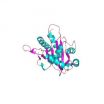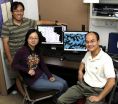(Press-News.org) Researchers at UCLA's Jonsson Comprehensive Cancer Center have discovered a new cell signaling pathway that controls cell growth and development, a pathway that, when defective, helps promote the formation of several major forms of human cancer, including lymphoma and leukemia.
The new pathway, part of a global DNA damage response, turns off 136 genes, including some that have are known to cause cancer because, unchecked, they can promote aberrant cell division.
"It's important to make sure this pathway works correctly, because it prevents cells from dividing excessively" said Dr. Michael Teitell, a professor of pathology and laboratory medicine, a Jonsson Cancer Center researcher and senior author of the study. "When this pathway is defective, cancers can happen."
The study appears in the Sept. 24, 2010 issue of the peer-reviewed journal Molecular Cell.
A widely used oral diabetes drug, Metformin, is known to activate the identified pathway and could possibly be protective against cancer in certain pathway defects. It's been shown through epidemiological studies, Teitell said, that diabetes patients on Metformin have lower incidences of lymphoma and leukemia, possibly because the drug is regulating pathway operation.
Additionally, new therapies that target the pathway could be developed to correct newly identified defects, thereby blocking the formation of cancer.
The study also revealed an unknown DNA damage response outcome. It is generally agreed that one of three things happen to cells in response to DNA damage – cells are temporarily arrested from growing so the damage can be repaired, cells go quiet and permanently stop dividing so they don't pass on the DNA damage, or cells simply die, a process known as apoptosis.
Teitell's study uncovered a fourth option - the DNA damage itself drives less mature cells to develop into more mature cells, in this case into antibody-secreting plasma cells, by turning off the 136 genes identified in the study. Defects in the newly discovered cell signaling pathway don't allow cells to progress to their natural end point by blocking normal gene silencing. The less mature cells become stuck where they are, dividing too rapidly and potentially resulting in lymphoma or leukemia.
Usually DNA damage is thought to be associated with environmental factors, such as exposure to too much sun or to toxic chemicals. Chemotherapy also damages cell DNA. However, Teitell and his team discovered that a normal process, the creation of antibodies to battle infection, results in physiologic DNA damage that also activates the identified signaling pathway.
Teitell, in previous studies, discovered that the gene TCL1 can cause B-cell cancers, including various types of lymphomas, if it is not turned off at the right time in development. Activation of this new signaling pathway, in fact, is the mechanism that shuts the TCL1 oncogene down at the appropriate time. If a pathway defect develops, TCL1 and the other 135 genes remain elevated and cancer may arise.
B-cells are lymphocytes that play a large role in immune responses and they make antibodies in response to infection or vaccination. They divide at the highest rate in the human body, faster than skin, hair or cells of the gastrointestinal tract. In making antibodies to fight infection or in response to a vaccine, these rapidly proliferating cells undergo DNA damage in order to make better, more effective antibodies. The body, in effect, is trading off the potential harm caused by added DNA damage in order to effectively ward off a more immediate invader.
The rapid cell cycling process that occurs during antibody assembly and testing by the immune system needs to be halted at the right time, Teitell said. The body naturally turns off that process after about two to three weeks. A defect in the new pathway interrupts that natural stop signal and blocks the production of effective antibody-producing cells, the plasma cells.
Mara Sherman, the first author of the study who worked as a graduate student in Teitell's lab, said the paper "reflects an exciting and emerging connection between DNA damage response pathways and cell differentiation."
"Our work points to this DNA damage-response pathway as a potential, novel therapeutic target for the treatment of B-cell lymphoma," Sherman said. "Combined with several intriguing recent studies, our work further suggests that pathways with established roles in genome maintenance may also drive the differentiation of stem and progenitor cell populations."
Patients at risk for developing B-cell related cancers could be screened for genes that, when not turned off, are a signature indicating pathway defects. The pathway also could be playing a role in the development of lung, colon and other major cancer types, Teitell said.
Going forward, Teitell and his team will further study the pathway to detail all aspects of its operation so new therapies can be developed to fix it when something goes wrong.
INFORMATION:
The study is funded by the National Institutes of Health and the Leukemia & Lymphoma Society.
UCLA's Jonsson Comprehensive Cancer Center has more than 240 researchers and clinicians engaged in disease research, prevention, detection, control, treatment and education. One of the nation's largest comprehensive cancer centers, the Jonsson center is dedicated to promoting research and translating basic science into leading-edge clinical studies. In July 2010, the Jonsson Cancer Center was named among the top 10 cancer centers nationwide by U.S. News & World Report, a ranking it has held for 10 of the last 11 years. For more information on the Jonsson Cancer Center, visit our website at http://www.cancer.ucla.edu.
END
The Office of Naval Research Global (ONR Global) continues to pursue aggressive energy goals established by Secretary of the Navy Ray Mabus, with the design of a system that controls electrical flow for lighting, a highly efficient platform that may spark a new era of power savings.
Designed by the Tokyo Institute of Technology and fine-tuned by researchers at MERSTech in partnership with the ONR Global's office in Tokyo, the Magnetic Energy Recovery Switch (MERS) harnesses and recycles residual magnetic power that is produced by electrical current. By using a device ...
Scientists at the Institute for Research in Biomedicine (IRB Barcelona) headed by the coordinator of the Structural and Computational Biology Programme, Miquel Coll, have published a new study that demonstrates that raltegravir, the drug approved in 2007 for the treatment of AIDS that is sold by Merck under the name Isentress, cancels the function of an essential protein for the replication of one kind of herpes virus. This study, published in the journal Proceedings of the National Academy of Sciences (PNAS), is the first step towards the development of a drug against ...
Scientists at the University of Liverpool have found that high levels of a stress hormone in recovering alcoholics could increase the risk of relapse.
The study showed that cortisol, a hormone produced by the adrenal gland in response to stress, is found in high levels in chronic alcoholics, as well as those recovering from the condition. Researchers found that this could result in impaired memory, attention and decision-making functions, which could decrease the patient's ability to engage with treatment.
Chronic alcoholism is a disabling addictive disorder, characterised ...
Boston, MA -
The Tufts Clinical and Translational Science Institute (CTSI) today issued a landmark report from a multi-state study on psychotropic medication oversight in foster care. Led by Laurel K. Leslie, MD, MPH at Tufts CTSI, Christopher Bellonci, MD at Tufts Medical Center and Justeen Hyde, PhD at Cambridge Health Alliance, the study examined state policies and practices in 47 states, including Massachusetts, and the District of Columbia regarding the use of medication for treating behavioral and mental health problems in foster care children and adolescents ages ...
Researchers from Utrecht University who studied the effect of negative emotions on pain perception in women with and without fibromyalgia found that anger and sadness amplified pain equally in both groups. Full findings are now online and will publish in the October print issue of Arthritis Care & Research, a journal of the American College of Rheumatology.
Fibromyalgia (FM), a chronic pain condition, has among the largest impact of all rheumatic and chronic pain conditions. In addition to chronic, widespread pain, patients report accompanying symptoms such as fatigue, ...
New research has found that a genetic variant which reduces the chance of contracting diseases such as tuberculosis and leprosy is more prevalent in populations with long histories of urban living.
The research, published in the journal Evolution, shows that in areas with a long history of urban settlements, today's inhabitants are more likely to possess the genetic variant which provides resistance to infection.
In ancient cities, poor sanitation and high population densities would have provided an ideal breeding ground for the spread of disease. Natural selection ...
In many developing countries, the absence of surface-based air pollution sensors makes it difficult, and in some cases impossible, to get even a rough estimate of the abundance of a subcategory of airborne particles that epidemiologists suspect contributes to millions of premature deaths each year. The problematic particles, called fine particulate matter (PM2.5), are 2.5 micrometers or less in diameter, about a tenth the fraction of human hair. These small particles can get past the body's normal defenses and penetrate deep into the lungs.
To fill in these gaps in surface-based ...
AMARILLO - Wheat streak mosaic virus is the most prevalent disease in the southwestern wheat producing region of the U.S., according to a Texas AgriLife Research scientist.
Dr. Charlie Rush, AgriLife Research plant pathologist in Amarillo, is assembling several teams of scientists to work on the disease from every aspect: vector to diagnosis and mapping to control.
"There are other diseases of concern, but wheat streak mosaic is always found somewhere in this wheat growing region, and every couple of years, we have an epidemic of it," Rush said.
Several issues cause ...
DURHAM, N.C. – While scientists have spent the past 40 years describing the intricate series of events that occur when one mammalian cell divides into two, they still haven't agreed on how the process begins.
There are two seemingly contradictory theories, which now may be reconciled by a third theory being proposed by Duke University bioengineer Lingchong You. These findings could provide insights into the initiation of disease, such as cancer, which is marked by uncontrolled cell proliferation.
During proliferation, the DNA within the nucleus of a cell makes a copy ...
AMES, Iowa – A research team led by Edward Yu of Iowa State University and the Ames Laboratory has discovered the crystal structures of pumps that remove heavy metal toxins from bacteria, making them resistant to antibiotics.
The findings are published in the Sept. 23 issue of the journal Nature.
Yu – an Iowa State associate professor of chemistry, of physics and astronomy, of biochemistry, biophysics and molecular biology and an associate of the U.S. Department of Energy's Ames Laboratory – said the finding gives researchers a better understanding of bacterial resistance ...

